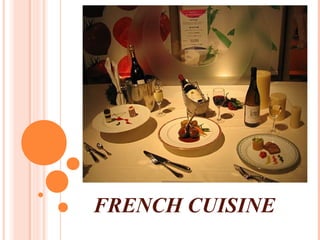
French cuisine
- 2. ORIGIN French cuisine is a style of cooking originating from France. French cuisine was codified in the 20th century by Georges Auguste Escoffier to become the modern version of haute cuisine. Gastro-tourism and the Guide Michelin helped to bring people to the countryside during the 20th century and beyond, to sample this rich bourgeois and peasant cuisine of France.
- 3. CULTURE OF FRENCH FOOD French cuisine is extremely diverse France's extraordinary range of different geographies and climates which support the local production of all types of ingredients, and France's long and varied history. In many ways, an understanding of the culture of French food and recipes is an understanding of France itself. Meals range from the very basic, such as the traditional baguette plus cheese plus inexpensive wine, to very elaborate affairs than can involve a dozen courses and different wines consumed over several hours.
- 5. REGIONAL INFLUENCES ON FRENCH FOOD Local availability- The French, a nation of gourmets, know that the best food is made from local ingredients, which are fresher and of better quality than items which have been transported long distances. Neighbouring countries and immigration- Areas of France which border on other countries have incorporated some of the cuisine of their neighbors. History and economic conditions- The culture, lifestyle and economic conditions over a long period of time have formed the development of local food traditions. The Italian connection- In 1533, Catherine brought an entourage of Italian chefs with her to France, who introduced to France a variety of dishes, food preparation and dining practices.
- 7. COOKING STYLES Classical French cuisine (also known in France as cuisine bourgeoise). This includes all the classical French dishes which were at one time regional, but are no longer specifically regional. Food is rich and filling, with many dishes using cream-based sauces. Haute cuisine is classical French cuisine taken to its most sophisticated and extreme. Food is elegant, elaborate and generally rich. Meals tend to be heavy, especially due to the use of cream and either large portions or many smaller portions. There is a strong emphasis on presentation and the meal is expensive
- 8. Cuisine Nouvelle. This style developed in the 1970s, as a reaction against the classical school of cooking. The food is simpler and lighter. Portions are smaller and less rich. Cuisine du terroir. This focuses on regional specialties and is somewhat more rustic in nature. Local produce and food traditions are the main focus.
- 10. INDISPENSABLE INGREDIENTS Wine and cheese Aside from bread and water, the most common accompaniments to a French meal are wine and cheese. Unlike other countries, in France wine is considered a standard part of everyday meals, and is neither expensive nor reserved for special occasions. With everyday meals, ordinary wines are served, although it is expected that the style of wine match the style of food In addition to its use in cooking, cheese is often served as a course in itself. In this case, it is served after the main meal but before dessert.
- 12. STRUCTURE OF MEALS BREAKFAST Le petit déjeuner (breakfast) is often a quick meal consisting of "tartines" (slices) of french bread with jelly, croissants or pain au chocolat (a pastry filled with chocolate) along with coffee or tea.
- 13. LUNCH Le déjeuner (lunch) was once a two hour mid-day meal but has recently seen a trend toward the one hour lunch break . In large cities a majority of working people and students eat their lunch at a corporate or school cafeteria, which normally serve complete meals.
- 14. NER DIN Le dîner (dinner) often consists of three courses, hors d'oeuvre or entrée (introductory course often soup), plat principal (main course), and a cheese course or dessert, sometimes with a salad offered before the cheese &dessert would be fresh fruit. The meal is often accompanied by bread, wine and mineral water.
- 15. BEVERAGES French cafés serve some of the world's best coffee, but each of us has our own preferences. Café (kuh-fay) is plain coffee with nothing added, but is strong as it is brewed like espresso. Café au lait (kuh-fay oh-lay) is a popular French coffee style that has been popularized in America, as it's served in tres francais New Orleans at Café du Monde.
- 16. Café crème (kuh-fay khremm) is, as it sounds, coffee served in a large cup with hot cream. Café Décafféiné (kuh-fay day-kah-fay-uhn-ay) is decaffeinated coffee. You will still need to tell them you want milk (lait) or cream (crème) with your coffee. Café Noisette (kuh-fay nwah-zett) is espresso with a dash of cream in it. It is called "noisette," French for hazelnut, because of the rich, dark color of the coffee. Café Americain (kuh-fay uh-meyhr-uh-kan) is filtered coffee, similar to traditional American coffee. Café Léger (kuh-fay lay-zjay) is espresso with double the water.
- 17. FRENCH SPECIAL OCCASIONS The two most important religious festivities of the year for Christians are Christmas and Lent.
- 19. White or black puddings (made with light meats and fats or animal blood) will almost always be a part of the dinner. A fat goose or a stuffed turkey will be the center of the menu while family specialties may shine after the nuts and cheese course. Special desserts such as buche de Noel may represent generations-old recipes or the best from the patisserie. In more recent years fish and seafood have been permitted together with the use of eggs and butter, yet there is a sense of restraint in the forty days of fasting menus.
- 20. POPULAR FRENCH DISHES TO BEAT THE COLD Butternut Squash Bisque Recipe Gratineed Onion Soup Recipe Chicken and sausage cassoulet recipe
- 21. CHICKEN IN CREAM SAUCE RECIPE BEEF BURGUNDY COQ AU VIN RECIPE TARTIFLETTERE .
- 22. N A H T U O Y K
